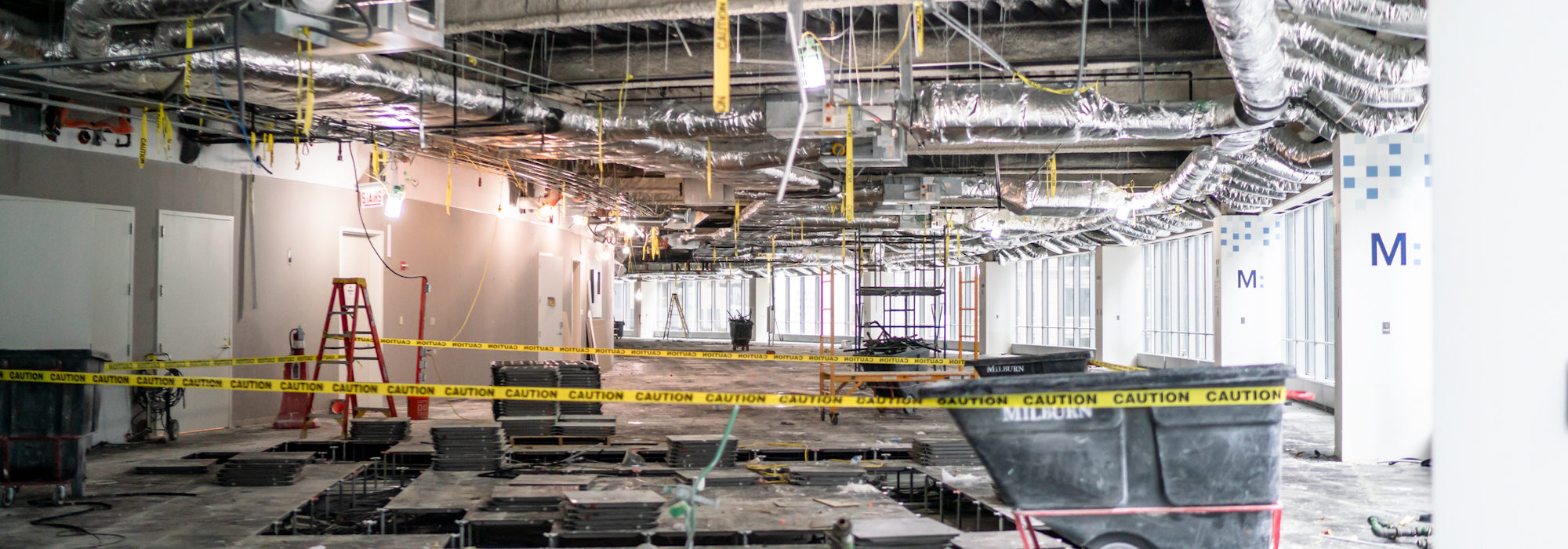

Selective interior demolition is one of MILBURN’s most common scopes of work. While we always enjoy demolishing entire buildings, much of the work we do involves the selective removal and disposal of specific interior elements, like ceilings, walls, flooring, and more.
One service under the interior demo umbrella that we provide to our clients is our data center decommissioning service. In today’s technologically advanced business environment, a wide variety of commercial and industrial buildings include vast information technology rooms that require careful demolition tactics.
Let’s discuss why data center decommissioning can be so tricky, what it entails, and why MILBURN is the best choice to perform this work at your next job site.
A harsh reality of technology, in general, is that it eventually becomes outdated. All tech has a life cycle. Not many people still use decades-old computer systems in their own homes, but you might be surprised by how many businesses and organizations are still operating 20th-century tech.
“Decommissioning” is just a fancy term for “unplugging.” Sometimes, this means replacing obsolete tech with newer systems. At other times, it means tearing the entire data center apart, leaving nothing but an empty room. MILBURN has experience with both of these extremes, and everything in between. Whether you’re looking to repurpose an old IT room or just get rid of some outdated equipment, we have the expertise to get the job done right.
In the case of large commercial and industrial data centers, the task of removing unwanted IT equipment has quite a few moving parts. Whether renovating the data center room for a different purpose or merely replacing equipment nearing the end of its life cycle, there are several essential steps to ensure the work gets completed safely and according to all legal guidelines.
There is quite a bit of preparation work to do when decommissioning any data center. The first step is merely figuring out what needs to be done to complete the project. What is the timeline? What is the scope of work? What is the client’s budget? Will we work during business hours or overnight? What needs to be removed, and which elements are to remain? We will answer these questions and more in the all-important planning phase of the project.
A significant part of this process is itemizing all of the equipment we need to remove; not only IT equipment — like servers, racks, modems, routers, firewalls, internal and external cooling units, control panels, etc. — but often elements like ductwork, piping, emergency generators, support equipment, storage cabinets, and more.
Once we’ve created an inventory list, we’ll cross-check our list with the data center’s existing configuration management database (CMDB) to ensure we’re not missing anything. The other major step in the itemizing process is determining which items removed will be repurposed or recycled, and which parts will be destroyed or otherwise disposed of.
Depending on the data center’s location and the equipment it includes — we will need to follow federal, state, and local government regulations to ensure we comply with all relevant legalities and guidelines. Decommissioned IT center equipment needs to be handled and destroyed with care, and we will accurately track and report the process for decommissioning each element of the data center.
This step is at the core of every data center decommissioning job. Once we’ve orchestrated our plan of attack, it’s time to execute it. If the client wants to back up any data to portable servers, they’ll need to do that in advance of this step. Again, depending on whether we’re “gutting” the data center to renovate it for another purpose or just getting rid of outdated equipment to make way for new servers, this phase of the project can vary considerably.
Before we finish our work, we’ll meet with the IT asset disposition (ITAD) professionals one more time to make sure we’re on the same page regarding unwanted equipment disposal. This is an excellent time to acquire equipment tracking numbers for repurposing, identifying additional opportunities to recycle assets, getting ahold of any packing equipment we might need (i.e., boxes, packing foam, etc.), and coordinating cleanup plans for after we finish our decommissioning work.
At this point, it’s time for us to remove the equipment from the job site. As we mentioned before, we should already know exactly where everything is going well before we get to this step. Some items will go to the landfill, some will be repurposed for use in other data centers, and some of them will be recycled, depending on the materials involved.
The expense of decommissioning a data center can vary considerably. The first significant variable is what our scope of work will be on the project. Are we just removing outdated servers and routers? Or are we essentially performing an interior demolition project on the entire data center, removing elements like HVAC systems, flooring, storage cabinets, etc.?
Other variables include how large the data center is, its location, whether we need to perform our work at night or during business hours, how much of the equipment can be repurposed or recycled, and more. As such, we can’t give any rough guidelines of what you can expect this process to cost for your specific project.
If you’re interested in hiring MILBURN to decommission your IT center, reach out to us at any time, and we can discuss the specifics of your data center. After we consult with you, we can nail down some set costs and prepare an estimate to give you a clear picture of how much you’ll need to spend.
Overall, data center decommissioning takes a great deal of planning and coordination between a wide range of stakeholders. That’s why you should only hire an experienced contractor like MILBURN, who has done this work before and knows what it takes to decommission an IT center of any size.
Back to all Blogs & News